Results 5,351 to 5,360 of 12094
Thread: Anandtech News
-
09-16-15, 05:31 PM #5351
Anandtech: Microsoft Quietly Rolls Out Windows RT Update To Enable Windows 10 Style S
When Windows 10 was first announced, one of the first questions was would this upgrade be available for Windows RT devices running on ARM based platforms. The answer was no, but Microsoft said that it would bring some of the functionality of Windows 10 to Windows RT users though an update sometime after Windows 10 shipped. Apparently that day was yesterday, as Microsoft pushed out patch KB3033055 which enables the Windows 10 style Start Menu in Windows RT.
- Header. This is where the user account picture and power button appear.
- Pinned List. Apps that are pinned for easy access appear here.
- Most Frequently Used applications list (MFU). Apps that are frequently used but not pinned anywhere else will appear here.
- All Apps button. Selecting this button displays the All Apps list.
- Search text box. Typing here begins a search.
- App grid. Both Immersive and Win32 apps can be pinned, unpinned, and resized in this area.
For those with a Windows RT device, this update should come automatically through Windows Update. Since Windows RT is mainly on tablet style devices, the Start Menu may actually not be that useful, so you can enable or disable the Start Menu through the taskbar properties on the desktop.
It functions much like the Windows 10 style one, including pinning apps and such, but the actual design of it appears to be closer to what was available on older versions of Windows 10 during the preview period.
The other Windows 10 feature coming is circular frames for user account pictures. Unlike the Start Menu though, there is no method to enable or disable this, it is just going to be there.
Much like Windows Phone 7.8, Windows RT is now a dead platform and Microsoft has given it the smallest of upgrades to end its life. Since it is not running the Windows 10 kernel, Windows RT will never have access to the Windows 10 store, nor the Universal Windows App platform which launched with Windows 10. It instead will forever stay on the older WinRT framework which debuted with Windows 8.
I would have liked to include screenshots from my own Surface RT for this post, but it stopped working a couple of months ago, and clearly there is no need to replace it.
Source: Microsoft Support via ZDNet
More...
-
09-16-15, 08:30 PM #5352
Anandtech: Corsair Partners with MSI, Enters High-End Video Card Market With The Hydr
Closed loop liquid cooled (CLLC) video cards have become an increasingly important part of the video card industry over the past couple of years. Though liquid cooling isn’t by any means new, it has until very recently been a true niche in the market, typically limited to aftermarket alterations of reference cards. More recently however we have seen the GPU vendors and their board partners embracing first and second party solutions, with companies like EVGA shipping complete liquid cooled solutions, and AMD going so far as to using liquid cooling on their reference cards such as the Radeon R9 Fury X. At the end of the day liquid cooling has allowed customers and system builders alike to put together denser and quieter systems, particularly when it comes to accommodating video cards over 250W.
Not surprisingly then, high-end CLLC-equipped video cards is a bright spot in an otherwise tepid video card market, offering an avenue of growth when other areas of the market are in decline. The potential for growth in turn attracts new competitors to the market, and that is particularly the case today for Corsair.
This evening the venerable PC components and cooling company is announcing that they are entering the high-end video card market. However rather than going into full video card manufacturing ala the traditional board partners, Corsair will be entering just the high-end segment of the market, and will be partnering with MSI to do so. The two companies will be combining their strengths – MSI’s board development expertise and Corsair’s cooler expertise – to develop high-end closed loop liquid cooled video cards to be sold under the Corsair brand.
The first video card developed under this partnership is the simply named Corsair Hydro GFX. The card is a CLLC-equipped GeForce GTX 980 Ti, combining an MSI card design with Corsair’s Hydro series 120mm H55 CLLC. Along with the integrated CLLC Corsair will also be shipping the card with a factory overclock – running the GPU at 1190MHz base clock and 1291MHz boost clock – in order to further boost the performance of the card. Overall Corsair estimates that the Hydro GFX should outperform the reference GTX 980 Ti by 15% by virtue of the CLLC eliminating thermal throttling combined with their factory overclock.GeForce GTX 980 Ti Specifications Corsair Hydro GFX Reference GTX 980 Ti CUDA Cores 2816 2816 Core Clock 1190MHz 1000MHz Boost Clock 1291MHz 1075MHz Memory Clock 7.096GHz GDDR5 7.01GHz GDDR5 Memory Bus Width 384-bit 384-bit VRAM 6GB 6GB TDP 250W 250W GPU GM200 GM200 Length 10.5 Inches 10.5 Inches Width Double-Slot +
120mm RadiatorDouble-Slot Warranty 3 Years Varies Launch Date 10/2015 06/01/2015 Launch Price $739 $649
Meanwhile judging from the pictures and the specifications provided to us by Corsair, it looks like this card is a reference or near-reference board supplied by MSI, with the H55 and accompanying video card shroud taking the place of a normal cooler. This is notable since it means the card retains NVIDIA’s standard 250W power limit. Out of the box performance then is going to be limited to what Corsair and MSI can squeeze out of 250W – which is where the 15% number comes from – however with a CLLC attached there is clearly of potential for significant unofficial overclocking through BIOS modifications. I suspect having MSI handle the board will be helpful in that respect.
For Corsair getting into the high-end video card market is an interesting and initially unexpected move, though one that makes sense looking at their product portfolio. The company sells cases, coolers, and PSUs; everything needed to house and power a video card. And with the company increasingly focusing on small footprint cases such as the Bulldog, ensuring that there are suitable high-performance video cards to install in their cases makes all the more sense. Ultimately this move allows Corsair to dip their toes into a profitable segment of the video card market while ensuring that there is a supply of suitable cards for their small footprint cases, and of course that customers can buy it from Corsair along with their case and CPU cooler.
Meanwhile in the long term while the Hydro GFX is so far Corsair’s first and only card, the deal does leave the door open to further products from Corsair. I suspect that if the Hydro GFX is successful we’ll see further cards from Corsair and MSI once the next generation of cards lands later next year.
Finally, as for the Hydro GFX, Corsair will be releasing the card in October through their website. The MSRP will be $739, which is essentially a $90 mark up over a reference GTX 980 Ti in exchange for the factory overclock and integrated CLLC. Meanwhile Corsair is not the first vendor to get into selling CLLC-equipped GeForce cards, so the Hydro GFX will be going up against cards from vendors such as EVGA who are already shipping similar products.
More...
-
09-17-15, 08:00 PM #5353
Anandtech: The Death of Intel’s Broadwell Has Been Greatly Exaggerated - Socketed Bro
To hop right into the heart of matters, IT World published an article earlier this afternoon stating that Intel was discontinuing their two desktop Broadwell socketed SKUs, the Core i7-5775C and the Core i5-5675C. The two SKUs are notable because they are to date the only socketed Broadwell processors on the desktop, and they are also the only socketed desktop Core processors available with a GT3e Iris Pro GPU configuration – that is, Intel’s more powerful GPU combined with 128MB of eDRAM.
The idea that these processors were discontinued came as quite a shock with us, and after asking Intel for more details, the company quickly responded. Intel has made it very clear to us that these processors have not been discontinued, and that the company continues to manufacture and sell the processors as part of their current Broadwell lineup.
While the company doesn’t have an immediate explaination for the confusion at this time, we believe it may stem from a mix up over Intel’s plans for GT3e/GT4e Skylake parts on the desktop. In short, the company does not have any socketed GT3e/GT4e Core family parts on their roadmap for Skylake, so these Broadwell parts will not be seeing a Skylake refresh. That said, it should also be noted that Intel has not yet begun to ship GT3e/GT4e Skylake chips in other form factors (e.g. the 45W mobile H series), so Intel’s current Broadwell SKUs remain as their top-of-the-line SKUs for graphics across all segments, and it’s likely that will remain the case until 2016.
Part of the confusion may also stem from a lack of good supply for these processors in the US. Though we’ve seen evidence that the supply is ample in Europe and Asia, retailers such as Newegg have regularly been out of stock of these two processors since their launch in June. Intel’s last comment on the matter, made to the Tech Report back in August, is that the overall supply situation should pick up through Q3, which at this point is the rest of September. After which these SKUs will remain available and Intel’s top desktop graphics SKUs throughout the run of Skylake.
More...
-
09-17-15, 08:30 PM #5354
Anandtech: Amazon Releases New Fire TV
Today Amazon released a refresh of its Fire TV media player and mini-console. The original device was unveiled in April 2014 and the 2015 version sees some upgrades in the internal components and connectivity.
The biggest change is the upgrade from the original Snapdragon 600 to MediaTek's new MT8173 SoC. The MT8173 was originally announced at MWC this year and surprised a lot of people as the Taiwanese semiconductor vendor was the first to show off working prototypes with ARM's new Cortex A72 CPU core.
The new SoC is a 2x2 big.LITTLE configuration with 2 A72 cores clocked in at 1989MHz and 2 A53 cores at 1573MHz. The new CPUs should give a significant performance boost over the Krait 300 found in the 2014 variant.Fire TV (2014) Fire TV (2015)SoC Qualcomm APQ8064
Snapdragon 600
4x Krait 300 @ 1.7GHz
Adreno 320 @ 400MHzMediaTek MT8173C
2x Cortex A72 @ 1989MHz
2x Cortex A53 @ 1573MHz
Power VR GX6250 600MHzRAM 2GB Storage 8GB 8GB + microSD Connectivity 5.5 mm DC Jack
Type A HDMI 1.4b output, w/HDCPOptical Audio (TOSLINK)
10/100 Ethernet
USB 2.0 Type A
802.11a/b/g/n
2x2 MIMO5.5 mm DC JackType A HDMI 2.0 output, w/HDCP 2.2microSD
10/100 EthernetUSB 2.0 Type A
802.11a/b/g/n/ac
2x2 MIMOOS Fire OS 3.0Fire OS 5.0
The new SoC also allows for hardware HEVC decoding and Amazon is touting this as the main feature of the new SKU as it allows for halving of the required bandwidth to stream 1080p content or allows for 4Kp30 content playback. Alas it seems 4Kp60 is not par of the course and thus makes new Fire TV not quite as future proof as one would have hoped. The new unit comes with a new HDMI 2.0 port sporting HDCP 2.2 compatibility and allows connecting a TV or monitor at up to 2160p at 24/25/30/50/60Hz.
An important change in the connectivity is the dropping of the TOSLINK optical audio out connector in favour of a microSD slot. Also added is 802.11ac Wi-Fi connectivity, still sporting a 2x2 MIMO antenna configuration.
As an accessory to the Fire TV, Amazon also released a new gaming controller, aptly named the Amazon Fire Game Controller. The controller is equipped with the same voice-control functionality that the Fire Voice Remote comes with, thus being able to use replace it as the main controller/remote.
The new Fire TV starts shipping on the 5th of October for $99.99 without the controller or $139.99 for the Gaming Edition which contains both the media play and the controller. Amazon also now releases the original Fire TV Stick with the Voice Remote for $59.99.
More...
-
09-18-15, 03:32 PM #5355
Anandtech: Jim Keller Leaves AMD
AMD’s history has been well documented, especially given several reorganizations in the early part of this decade along with changes in senior staff and how both its market share in CPU and GPU markets is progressing. Today we have learned that one of those senior staff, the head of the CPU group Jim Keller, is to leave AMD effective September 18th (today). Readers may remember that Jim Keller was a recent re-hire in 2012, tasked with leading AMD's CPU group and helping the company develop new core processor architectures in order to bring AMD's architecture in line the competition.
Jim Keller has worked at AMD before, most notably developing the K7 and K8 processors that formed the basis of much of AMD’s success at the turn of the century. This includes assisting in the generation of the x86-64 instruction set that would form the basis of many of the x86 based computers people used today. At other points in time Jim has also spent several years each at Apple helping design their A4 and A5 SoCs as well as at DEC on Alpha processors, giving him a wide degree of experience in CPU development that AMD has been tapping during his latest tenure there.
As a re-hire at the top of the CPU chain, Keller's latest project at AMD was to develop the next generation of high performance processors for AMD and to build a team around the concept of PC performance. This was announced as a rapid departure from the module design of Bulldozer-based cores sharing parts of a processor and towards a new base architecture called Zen. Other projects in the pipeline at AMD CPU group include ARM-based AMD processors (K12), an ARM counterpart of sorts for Zen that is set to launch later on.
As for the big question, the state of Zen, along with confirming that Keller is leaving the company today, AMD is also officially reiterating that their roadmaps are still on course, with Zen set to come to market in the latter half of 2016 and a first full quarter of revenue to be reported in 2017. Given the long (4+ year) design cycles for a modern high-performance CPU, at this point in time all of the "heavy lifting" on Zen development should be done. With only a year or so to go before launch, the rest of Keller's team at AMD will be focusing on fixing bugs and bringing products to manufacturing.
As a result while the loss of Keller is certainly a significant one for AMD, Keller's architecture work on Zen should already be complete, which is likely why we are seeing him leave at this time. And as a quick aside to give you an idea of CPU development timelines, by comparison, Jim's work on K8 was done over 3 years before K8 shipped in 2003. Consequently the biggest loss for AMD here shouldn't be Zen-related, but rather that they won't have Keller's talents to call upon for further refinements of Zen or for a post-Zen architecture.
Meanwhile leadership of the CPU architecture team in Keller's absence will be turned over to CTO Mark Papermaster, who will be leading the group as they wrap up work on Zen. AMD is calling Mark the "acting leader" of the group, so this is likely an interim posting while AMD looks to find or promote someone to lead the CPU architecture group on a permanent basis. Otherwise as we're approaching the end of the fiscal quarter, AMD is in their quiet period, so AMD is limited in what they can say at this time. I suspect we'll hear a bit more on the plan for the final year of Zen development in the company's Q3 earnings release, which will be on October 14th.
Finally, it will be interesting to see if and when Keller will pop up next in the industry. Given his history of switching jobs to work on new CPU projects and his high level of skill which has allowed him to so freely move between companies, we may yet see Keller show up on another CPU project in the future. On the other hand after having worked for AMD twice and Apple, Keller has certainly earned an early retirement. In the meantime with the launch of Zen closing in for AMD, all eyes will be on just what Keller and his team have put together for AMD's next generation CPU.
Source: AMD
Top image (from left): Mark Papermaster (CTO), Dr. Lisa Su (CEO), Simon Segars (CEO of ARM), Jim Keller
More...
-
09-18-15, 07:00 PM #5356
Anandtech: Google Launches Android Pay On Google Play
Today Google officially began the roll out of Android Pay by releasing the Android Pay application on the Google Play Store. Android Pay was announced earlier this year at Google I/O and is Google's new NFC based payment service for Android smartphones. It's effectively a successor to Google Wallet, although Google Wallet still exists as a service for sending P2P payments. The rollout of the new application actually began last week, but today the application should be available to all users for direct download.
Android Pay will work on any smartphone running Android 4.4 KitKat or newer so long as the phone has NFC hardware. At launch the service will only be available in the United States, and will support a variety of credit and debit cards from various US banks and credit unions. There will also be support for gift cards and loyalty cards from retailers.
Google's Android Pay website details a number of stores that support Android Pay, but since the service uses NFC it will work at any store that has tap to pay support. It will also work in Android applications that have partnered with Google to support Android Pay payments, and you can view a list of those applications along with a list of supported banks and credit unions on the Android Pay site.
More...
-
09-18-15, 10:31 PM #5357
Anandtech: Windows 10 Build 10547 Brings Some Nice Changes For Insiders
It’s Friday and Gabe Aul has unleashed another new build of Windows 10 to people in the Windows Insider Program’s fast ring. Unlike the last build which was mostly just some cosmetic changes, build 10547 looks to fix a few of the complaints that I had with Windows 10 in our review.
One thing that bothered me was that the Start Menu would not allow you to create groups more than three “medium” tiles wide, and with this update, users can select “Show more tiles” in the personalization settings which allows a fourth column of tiles. It’s nice for the desktop, but this should be very beneficial to tablet mode which I felt was wasting a lot of space with just the three column width. Having four columns also allows for two wide or large tiles to be on the same row, which is a much better solution than having to plug holes with smaller tiles even if you don’t really want them. Hopefully the wording changes on the setting, since Show more tiles is not really what the setting is doing, and it is of course a fall back to the Windows 8.1 setting with the same name which actually did allow you to put more tiles on the Start Screen.
Tablet mode also gets some tweaks. I felt that Windows 10 actually lost a step compared to Windows 8.1 in just touch usage. Microsoft appears to be trying to bring back some of the good tablet features that Windows 8 had. A small change which should actually be a nice change is that when you have two apps snapped in tablet mode, you can now snap another app over one of those, just like in Windows 8.1. Microsoft has a graphic that shows the app teeter from side to side to show you which side it is going to replace. It’s a small change, but welcome. Windows 8.1 was pretty solid as a tablet operating system so it’s great to see Windows 10 adding some of those features back.
The core apps are also being updated constantly, and we’ve seen some good changes to things like Mail getting an option to disable conversation view, and the photos app keeps getting iterated to make it a better experience. It has been updated again to make it more obvious which photos are on your PC and which are in the cloud. Other core apps like Xbox app are getting updated, and the Xbox app is gaining a Beta program too much like the Xbox itself has.
The Start Menu has gotten some fixes, and with this build the 512 app limit in the Start Menu has been increased to 2048 apps. While there should not really be a limit here, 2048 should be enough for pretty much anyone as far as installed apps.
Cortana, which before required a Microsoft Account, is now usable with a local account. I’ll have to test to see exactly what this means. In the original version of Windows 10, enabling Cortana with a local account would force the system to switch the account login to a Microsoft Account. It’s not clear from the release notes if you can just log in to Cortana with a Microsoft Account now instead of switching the login, or if it is actually usable with just a local account.
There are, as usual, a few known issues as well including Store Apps may not update automatically, so please check out the known issues before installing in case one of them will directly affect you.
Source: Windows Blog
More...
-
09-21-15, 01:40 PM #5358
Anandtech: The MSI Z170A Gaming M7 Review: The Step Up to Skylake
June, July and August in 2015 have all been a roller coaster of desktop and processor news. Intel officially launched the Broadwell processors at Computex, with NVIDIA also entering the GTX 980 Ti graphics card into the market for 4K gaming. AMD soon followed with the Fury X and Fury graphics cards featuring high bandwidth memory, and then Intel’s Skylake processors burst through the door, along with Z170 motherboards giving more desktop options and dual-channel DDR4 memory to remain a focal point for the rest of the year. The first Z170 motherboard up on deck is the MSI Z170A Gaming M7 from MSI, a $230 mid-high push into the gaming-focused market.
More...
-
09-21-15, 02:30 PM #5359
Anandtech: Apple Releases watchOS 2
Five days ago Apple released iOS 9, the latest major release of their operating system for smartphones and tablets. They also planned to release the first major upgrade to watchOS, their operating system for the Apple Watch. Due to an unspecified bug that couldn't be fixed in time for the planned September 16th launch the release of watchOS 2 was delayed with no specific details about when it would be released other than that it would be soon. Five days later the bug has been fixed, and the update is now rolling out to users around the world.
The watchOS 2 update comes in at 517MB for the 38mm model, while the 42mm model may have a slightly larger update size due to higher resolution bitmaps and other assets. You can view our overview of what's new in watchOS 2 here, as well as on Apple's own watchOS 2 page.
More...
-
09-22-15, 03:53 AM #5360
Anandtech: Samsung Announces 950 Pro SSD, Their First Consumer V-NAND + NVMe SSD
We’re here at Samsung’s SSD Global Summit, the company’s annual SSD technology reveal. This event is typically held mid-summer, however with MERS concerns in South Korea this year, the company held off on the event until now.
To jump right into matters then, the centerpiece of Samsung’s consumer announcements today is the 950 Pro SSD, the latest iteration of the company’s flagship consumer SSD. The 950 Pro comes at an interesting time for Samsung and the industry as a whole, as we’re in the midst of many transitions: SATA to PCIe, AHCI to NVMe, and planar NAND to 3D/V-NAND. Consequently for Samsung, they are going all-in on all of those major transitions at once with the 950 Pro.
So let’s start with the base specifications. The 950 Pro marks Samsung’s transition from SATA to PCIe for their flagship consumer drive, and in doing so shifting the primary form factor from 2.5” to M.2. As a result the 950 Pro comes as a M.2 2280 drive, what is quickly becoming the common size for “full size” laptop SSDs.Samsung SSD Comparison 950 Pro 512GB 950 Pro 256GB SM951-NVMe 512GB 850 Pro 512GB Form Factor M.2 2280 2.5" SATA Controller Samsung UBX Samsung MEX Interface PCIe 3.0 x4 SATA III Protocol NVMe AHCI DRAM 512MB 512MB 512MB NAND Samsung V-NAND 32-layer 128Gbit MLC Samsung 16nm 64Gbit MLC Samsung V-NAND 32-layer 86Gbit MLC Sequential Read 2,500MB/s 2,200MB/s 2,150MB/s 550MB/s Sequential Write 1500MB/s 900MB/s 1,550MB/s 520MB/s 4KB Random Read (QD32) 300K IOPS 270K IOPS 300K IOPS 100K IOPS 4KB Random Write (QD32) 110K IOPS 85K IOPS 100K IOPS 90K IOPS Power 7.0W (burst)
5.7W (average)
1.7W (idle)6.4W (burst)
5.1 (average)
1.7W (idle)8.9W (peak) 3.3W (read)
3.0W (write)
0.4W (idle)Encryption AES-256, TCG Opal 2.0 N/A AES-256, TCG Opal 2.0 Endurance 400TB 200TB N/A 300TB Warranty 5 Year N/A 10 Year Launch Date October 2015 ~June 2015 July 2014
The 950 Pro is in turn is the first SSD shipping from Samsung that combines the company’s V-NAND technology with NVMe protocol support. Until now Samsung has offered V-NAND based drives using AHCI, such as the current 850 Pro. Alternatively Samsung offers NVMe drives to OEMs in the form of the SM951-NVMe, however this drive is built with planar NAND. And in the interim Samsung has announced the enterprise-level PM953, a drive which combines TLC V-NAND with NVMe, however as we still don’t have a release date for that drive it looks like the 950 Pro will be the first such drive to actually ship out of Samsung’s entire product lineup, never mind the consumer lineup.
The release of a V-NAND plus NVMe drive has been a long time coming, and should confer both performance and cost improvements. As we’ve seen with the NVMe SM951, just the switch to NVMe with planar NAND has greatly improved small I/O latency while also improving overall I/O consistency. V-NAND in turn further improves Samsung’s ability to scale up NAND density, and by extension bring down costs for any given capacity. The die size difference between Samsung’s 32-layer V-NAND and the smallest planar nodes is not overwhelming, but it will still help to push the envelope on price vs. capacity versus their current M.2 planar drives.
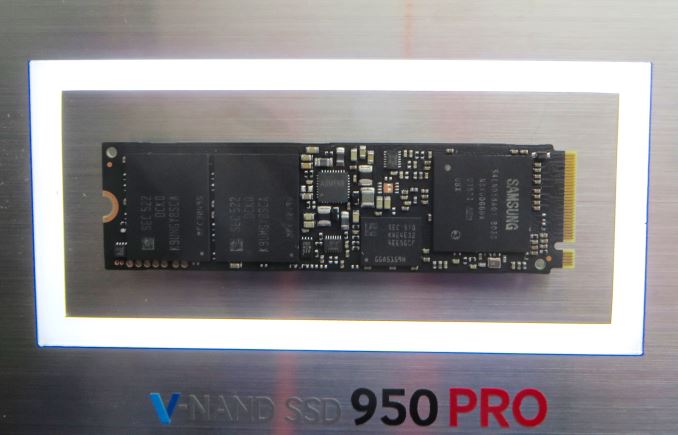
But compared to the 850 Pro in particular, we’re also seeing a shift from SATA to PCIe, which will significantly boost performance in this product segment. Samsung is using a PCIe x4 connection here, which gives upwards of 4GB/sec of bus bandwidth; Samsung’s official ratings are up to 2.5GB/sec reads, but this is still a large jump compared to the 600MB/sec limit imposed by SATA. Between the bandwidth improvements from PCIe and the I/O improvements from running NVMe over PCIe, Samsung should see significant gains in both sequential read/write performance and in small I/O client workloads.
Curiously, Samsung is only using their second-generation 32-layer V-NAND in these products. The company’s recently announced third-generation 48-layer V-NAND is not being used here, and so far Samsung has not announced any products that will be using it beyond the enterprise-level PM1633a, a high capacity drive for read-heavy workloads.
Consequently this means Samsung is using their 128Gbit 32-layer MLC V-NAND in the 950 Pro. This is the same generation V-NAND that is in last year’s 1TB and below 850 Pro, however the capacity is up from 86Gbit. I expect the use of denser NAND will have some kind of performance impact, but relative to the 850 Pro here the big change is really the interface, the controller, and the form factor.
The use of M.2 for the 950 Pro will impose capacity limits on the drive due to the smaller size of the M.2 form factor compared to 2.5” SSDs. This means that the 950 Pro will come in 256GB and 512GB capacities. Next year Samsung will be releasing a 1TB version of the drive based on 48-layer third-generation V-NAND once that tech is ready and plentiful for consumer drives.
Of course with the current capacity limit of 512GB, this is ¼ of where the 850 Pro currently tops out. Consequently we aren’t going to see the 950 Pro completely replace the 850 Pro like prior generations of Samsung’s drives have done. The 850 Pro will continue to sell as a higher capacity option, with a new 4TB drive to come.
As for the 950 Pro’s controller, Samsung is using their UBX controller here. This is the same controller that is featured in the existing SM951 OEM drives, making the big difference versus SM951 the use of V-NAND versus planar. Like the SM951, this means Samsung is using 512MB of memory to back the SSD controller, upgrading from LPDDR3 to LPDDR4.
In terms of features, the 950 Pro will support 256-bit AES. Perhaps more importantly though the drive will be bringing TCG Opal support for Microsoft’s eDrive standard, allowing the drive to do native encryption for BitLocker. Unfortunately this feature won’t be in the shipping firmware, and will be coming in a future firmware release for the drive.
Also of note on the OS front, Samsung will be shipping their NVMe driver with the 950 Pro as they have previously with the SM951. With Windows 8.1 there were some shortcomings with Microsoft’s generic driver, leading to manufacturers like Samsung producing their own driver. We’re still checking with Samsung and others over whether the Windows 10 driver improves on this situation at all, though Samsung has commented that their NVMe driver will work on Windows 10 as well.
As for rated speeds, the 512GB drive will be rated for 2.5GB/sec sequential reads and 1.5GB/sec sequential writes, with 12K and 43K read and write IOPS respectively for shallow consumer-style 4K queue depth 1 operations. Power consumption meanwhile is rated for 1.7W at idle, 5.7W average, and 7.0W maximum when bursting. Samsung doesn’t publish similar numbers for the SM951, so it’s not clear at this point how the shift to V-NAND impacts power consumption for Samsung.
Meanwhile write endurance ratings are up versus the 850 Pro. Whereas the 850 Pro 512GB was rated for 300TB and the 256GB 850 Pro was rated for 150TB, both 950 Pro models will be seeing a decent increase. The 256GB 950 Pro is rated for 200TB, a 50TB increase, and the 512GB 950 Pro is rated for 400TB, a 100TB increase. This works out to 781 writes over the lifetime of the drive, though in all practicality these drives should well exceed that. However at the same time Samsung has surprisingly cut back on their warranty length. Whereas the 850 Pro drives shipped with a 10 year warranty, the 950 Pro drives are getting a halved 5 year warranty. We’ll be catching up with Samsung later today to try to find out why the warranty period has been reduced.
Wrapping things up, Samsung tells us that the new 950 Pro drives will be going on sale in October. The 256GB drive will hit the market with an MSRP of $200, and $350 for the 512GB drive. Compared to the very difficult to find in retail SM951 these prices should be more than competitive, though compared to the current 850 Pro there will be a significant price premium at these MSRPs.
More...
Thread Information
Users Browsing this Thread
There are currently 17 users browsing this thread. (0 members and 17 guests)




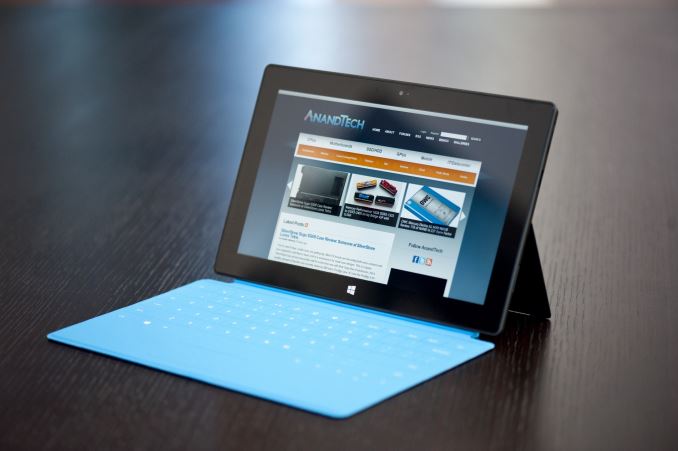



 Quote
Quote
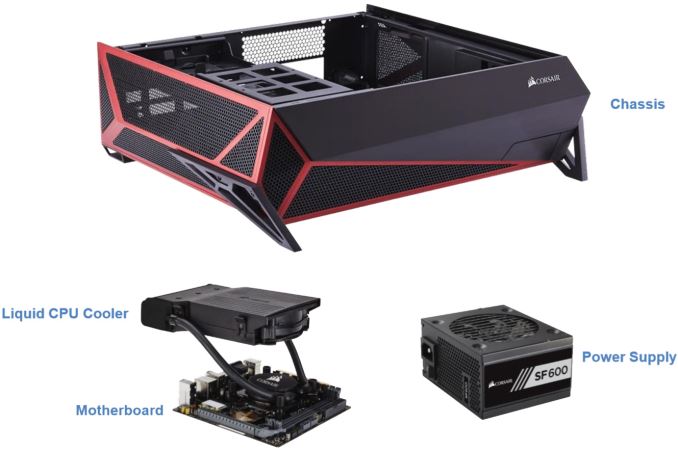

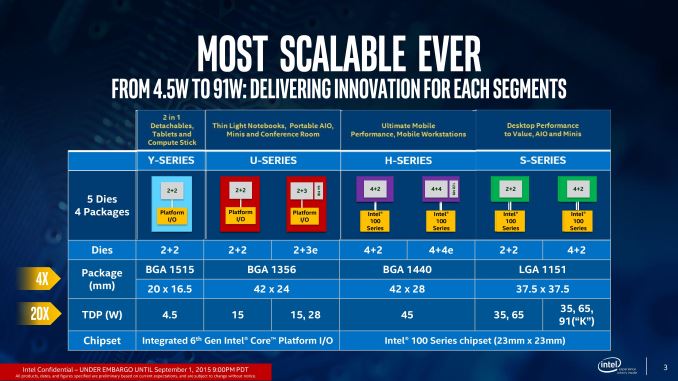
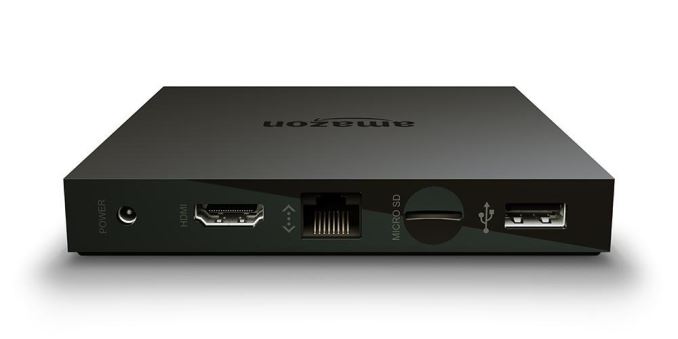




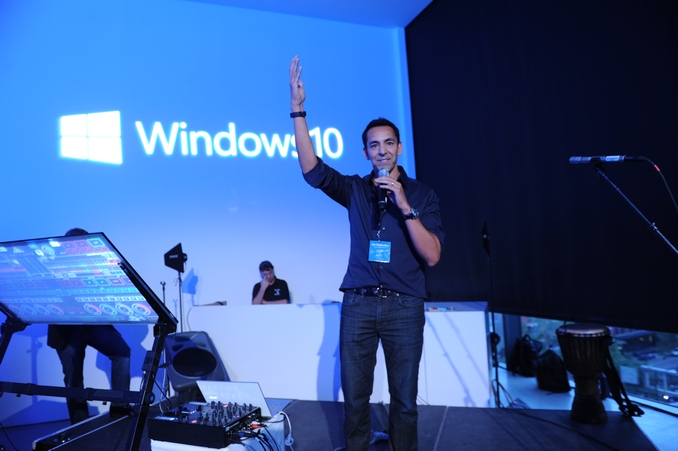



_575px.png)

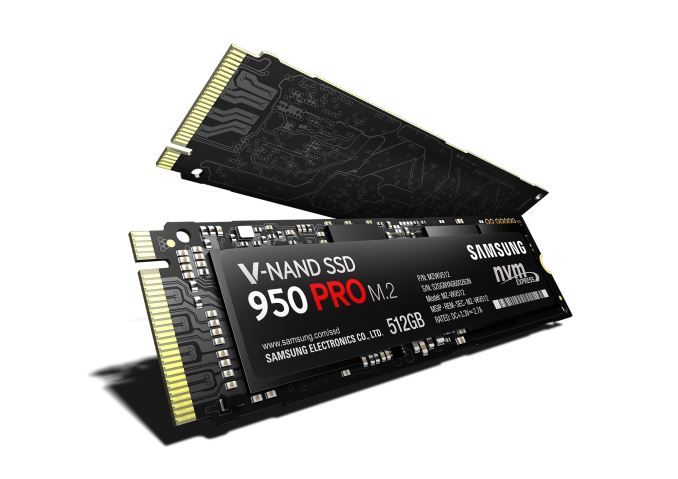
















Bookmarks